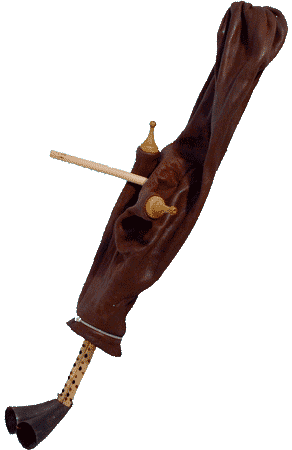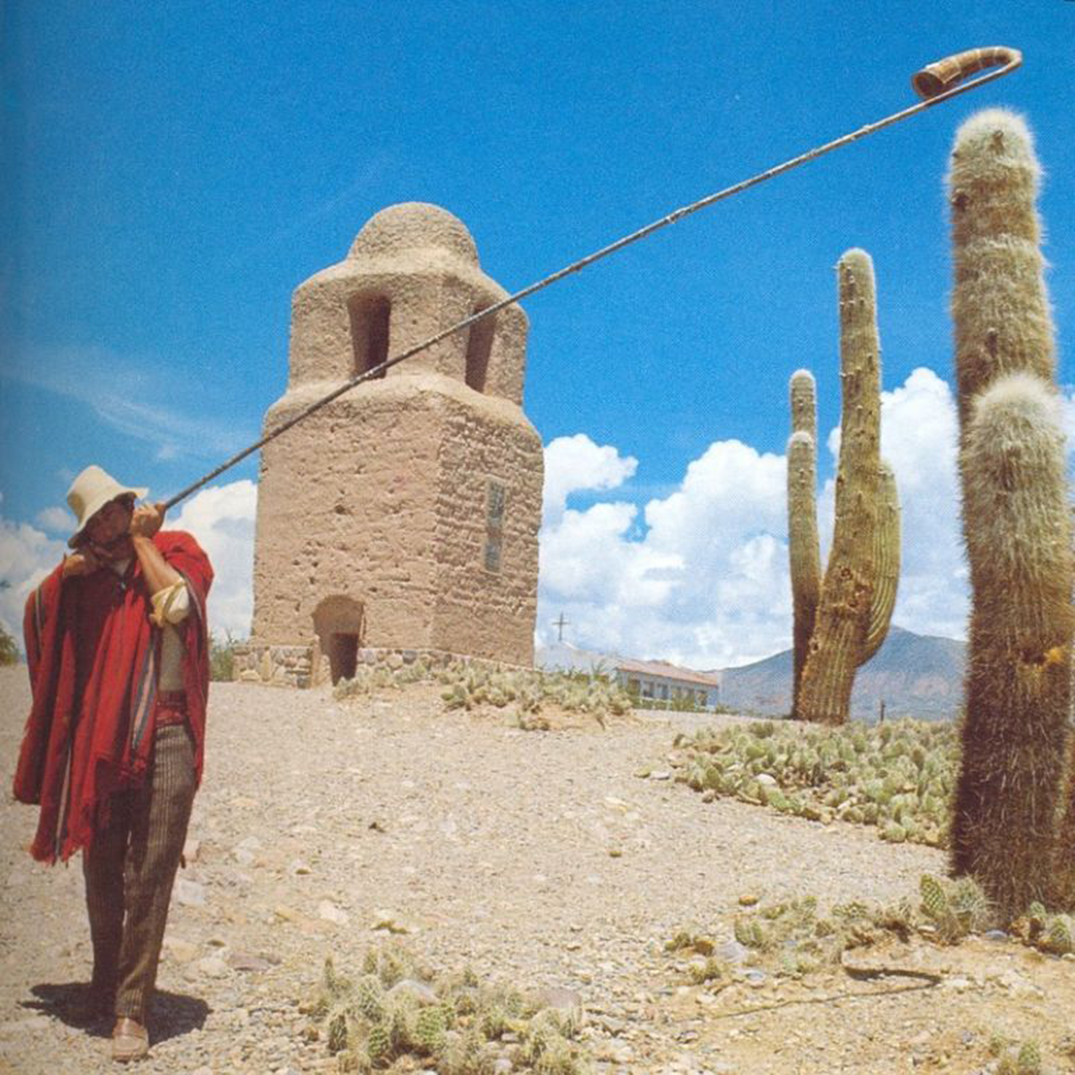|
Mezoued
The mizwad (mezoued, mizwid) (Algerian Arabic / Tunisian Arabic : مِزْود; plural مَزاود mazāwid, literally "sack," “bag,” or “food pouch”) is a type of bagpipes played in Tunisia and Algeria, The instrument consists of a skin bag made from ewe's leather, with a joined double-chanter, terminating in two cow horns, similar to a hornpipe (instrument).This instrument is played with a single-reed. The ethnomusicologist Anthony Baines stated that the term " zukra" is also used for this instrument. Bagpipe enthusiast, Oliver Seeler, states that this connection is incorrect. While the zukra may be similar, it is instead a wind instrument in Libya, similar to the mizwad.Seeler, Oliver.MEZOUED. Accessed 23 May 2012. Mizwad is a popular type of traditional music in Tunisia and Algeria which incorporates a type of North African drum called the darbouka as well as the mizwad. This music was originally considered the music of the countryside and the working class. It i ... [...More Info...] [...Related Items...] OR: [Wikipedia] [Google] [Baidu] |
Anthony Baines
Anthony Cuthbert Baines (6 October 1912 – 2 February 1997) was an English bassoon player and organologist who produced a wide variety of works on the history of musical instruments, and was a founding member of the Galpin Society.'' Experimental Musical Instruments'', volumes 12–13, 1996. Career Baines was born on 6 October 1912 in London. His older brother was the instrumentalist and composer Francis Baines. Philip Bate (2001). Baines, Anthony C(uthbert). ''Grove Music Online'' (Oxford University Press) He attended Westminster School and then read for a degree in natural sciences, specialising in chemistry, at Christ Church, Oxford (1933). He won a scholarship to the Royal College of Music to study the bassoon (1933–35). He performed with the London Philharmonic Orchestra (1935–48), interrupted by service during the Second World War.A. C. Baines (ed.): ''Musical Instruments Through the Ages'' (Harmondsworth: Pelican Books, 1961), cover text. In 1949 he became assista ... [...More Info...] [...Related Items...] OR: [Wikipedia] [Google] [Baidu] |
Algerian Musical Instruments
Algerian may refer to: * Something of, or related to Algeria * Algerian people, a person or people from Algeria, or of Algerian descent * Algerian cuisine * Algerian culture * Algerian Islamic reference * Algerian Mus'haf * Algerian (solitaire) * Algerian (typeface) See also * * Languages of Algeria * List of Algerians Notable Algerians include: Artists Actors * Hadj Abderrahmane, actor and comedian * Isabelle Adjani, French actress * Allalou, playwright, theatre director, and actor known as the father of Algerian theater * Mahieddine Bachtarzi, singer ... {{disambiguation Language and nationality disambiguation pages ... [...More Info...] [...Related Items...] OR: [Wikipedia] [Google] [Baidu] |
North African Musical Instruments
North is one of the four compass points or cardinal directions. It is the opposite of south and is perpendicular to east and west. ''North'' is a noun, adjective, or adverb indicating direction or geography. Etymology The word ''north'' is related to the Old High German ''nord'', both descending from the Proto-Indo-European unit *''ner-'', meaning "left; below" as north is to left when facing the rising sun. Similarly, the other cardinal directions are also related to the sun's position. The Latin word ''borealis'' comes from the Greek ''boreas'' "north wind, north" which, according to Ovid, was personified as the wind-god Boreas, the father of Calais and Zetes. ''Septentrionalis'' is from ''septentriones'', "the seven plow oxen", a name of ''Ursa Major''. The Greek ἀρκτικός (''arktikós'') is named for the same constellation, and is the source of the English word ''Arctic''. Other languages have other derivations. For example, in Lezgian, ''kefer'' can mean bot ... [...More Info...] [...Related Items...] OR: [Wikipedia] [Google] [Baidu] |
Bagpipes
Bagpipes are a woodwind instrument using enclosed reeds fed from a constant reservoir of air in the form of a bag. The Great Highland bagpipes are well known, but people have played bagpipes for centuries throughout large parts of Europe, Northern Africa, Western Asia, around the Persian Gulf and northern parts of South Asia. The term ''bagpipe'' is equally correct in the singular or the plural, though pipers usually refer to the bagpipes as "the pipes", "a set of pipes" or "a stand of pipes". Bagpipes are part of the aerophone group because to play the instrument you must blow air into it to produce a sound. Construction A set of bagpipes minimally consists of an air supply, a bag, a chanter, and usually at least one drone. Many bagpipes have more than one drone (and, sometimes, more than one chanter) in various combinations, held in place in stocks—sockets that fasten the various pipes to the bag. Air supply The most common method of supplying air to the b ... [...More Info...] [...Related Items...] OR: [Wikipedia] [Google] [Baidu] |
Erke
The erke (alternatively erque, coroneta, or quepa) is a large labrosone (lip reed) instrument native to the Gran Chaco of Bolivia, northern Chile, and the Argentine Northwest. Construction The erke is composed of two or more lengths of cane joined at the ends to form a single tube. The internal nodes of the canes are removed and the exterior is often wrapped with gut or wool. The end often has an amplifier made of cow horn or brass. The instrument is blown through at the other end, and may be three to seven metres in length. History Although in the latter half of the 20th century, Andean folkloric musical groups used the erke for secular music, among the indigenous and criollo peoples of the Andes the erke is used solely for ritual purposes. Traditionally, but not commonly, only adult men play the erke and it is considered profane to play the erke outside of a ritual context. The erke is commonly played during winter, as it is believed that playing it in spring or summer ... [...More Info...] [...Related Items...] OR: [Wikipedia] [Google] [Baidu] |
Mijwiz
The ''mijwiz'' (, DIN: ''miǧwiz'') is a traditional Middle East musical instrument popular in Palestine, Egypt, Syria, Lebanon and Jordan. Its name in Arabic means "dual", because of its consisting of two, short, bamboo pipes with reed tips put together, making the mijwiz a double-pipe, single-reed woodwind instrument. Background The mijwiz consists of two pipes of equal length; each pipe has around five or six small holes for fingering. It requires a special playing technique known as "circular breathing," which is tricky but produces a continuous tone, without pausing to take a breath. The mijwiz is played in the Levant as an accompaniment to either belly dancing or dabke, the folkloric line dance of the Levant. The mijwiz is most popular today in the Levant (Palestine, Lebanon, Syria and Jordan). Many popular folk songs either include the mijwiz on recordings, or include the instrument's name in the song's lyrics. One example is the famous Lebanese dabke song "Jee ... [...More Info...] [...Related Items...] OR: [Wikipedia] [Google] [Baidu] |
Habbān
The habbān (or hibbān) is a type of bagpipe used in the coastal regions of the Persian Gulf (especially Bahrain, Israel, and Kuwait). The term ''ḥabbān'' (''هبان'') is one of several Arabic terms for the bagpipes. The term is drawn from ''Hanbān'' (هنبان), the Persian word for "bag.". In Gulf states the term ''habban'' refers to the traditional Holi (inhabitants of the eastern coast of the Persian Gulf) bagpipe. The habbān is also called the jirbah (). It is similar to the Ney-anbān and jirba. While the term itself is generic, in Oman the term ''habban'' is used specifically for a nativized variant of the Great Highland bagpipe that has been incorporated into local music. See also * Jirba *Ney-anbān Ney-anbān (, numerous Latin spellings), is a type of bagpipe which is popular in southern Iran, especially around Bushehr. The term ''ney-anban'' literally means "bag pipe", - ''Nai, signifies a reed, pipe, &c, and Anban or Anbanah, a bag made ... * List of ... [...More Info...] [...Related Items...] OR: [Wikipedia] [Google] [Baidu] |
Darbouka
The goblet drum (also chalice drum, tarabuka, tarabaki, darbuka, darabuka, derbake, debuka, doumbek, dumbec, dumbeg, dumbelek, toumperleki, tumbak, or zerbaghali; / Romanized: ) is a single-head membranophone with a goblet-shaped body. It is most commonly used in the traditional music of Egypt, where it is considered the national symbol of Egyptian Shaabi Music. The instrument is also featured in traditional music from West Asia, North Africa, South Asia, and Eastern Europe. The West African djembe is also a goblet membranophone. This article focuses on the Middle Eastern and North African goblet drum. History The origin of the term ''Darbuka'' lies in the rural Egyptian Arabic slang word that changed "darb" meaning "to strike" into "darabuka". Goblet drums have been around for thousands of years and were used in Mesopotamian and Ancient Egyptian cultures. They were also seen in Babylonia and Sumer from as early as 1100 BCE. On Sulawesi, large goblet drums are used as temple ... [...More Info...] [...Related Items...] OR: [Wikipedia] [Google] [Baidu] |
Zukra
The ''zukra'' (or ''zokra'' or ''zoughara'', ) is a Libyan bagpipe with a double-chanter terminating in two cow horns; it is similar in construction to the Tunisian '' mizwad''. The instrument is played as a bagpipe in the south and west of Libya, but played by mouth without a bag (as a double clarinet) in the east. The instrument is played at feasts, weddings, and funerals. See also * Mizwad *Gaida *Rhaita *Mizmar (instrument) In Arabic music, a ''mizmār'' (; plural مَزَامِير ''mazāmīr'') is any single or double reed wind instrument. In Egypt, the term ''mizmar'' usually refers to the conical shawm that is called ''zurna'' in Turkey and Armenia. The mizmar ... References External links *Image of a zukra player in a band, in Bagpipes North African musical instruments Libyan musical instruments Arabic musical instruments Double-reed instruments {{Bagpipes-stub ... [...More Info...] [...Related Items...] OR: [Wikipedia] [Google] [Baidu] |
Single-reed Instrument
A single-reed instrument is a woodwind instrument that uses only one reed to produce sound. The very earliest single-reed instruments were documented in ancient Egypt, ancient Greece as well as the Middle East, and the Roman Empire. The earliest types of single-reed instruments used idioglottal reeds, where the vibrating reed is a tongue cut and shaped on the tube of cane. Much later, single-reed instruments started using heteroglottal reeds, where a reed is cut and separated from the tube of cane and attached to a mouthpiece of some sort. By contrast, in a double reed instrument (such as the oboe and bassoon), there is no mouthpiece; the two parts of the reed vibrate against one another. Reeds are traditionally made of cane and produce sound when air is blown across or through them. The type of instruments that use a single reed are clarinets and saxophone. The timbre of a single and double reed instrument is related to the harmonic series caused by the shape of the corpus. E ... [...More Info...] [...Related Items...] OR: [Wikipedia] [Google] [Baidu] |
At The Music School In Tozeur
AT or at may refer to: Geography Austria * Austria (ISO 2-letter country code) * .at, Internet country code top-level domain United States * Atchison County, Kansas (county code) * The Appalachian Trail (A.T.), a 2,180+ mile long mountainous trail in the Eastern United States Elsewhere * Antigua and Barbuda, World Meteorological Organization country code * Ashmore and Cartier Islands (FIPS 10-4 territory code, and obsolete NATO country code) * At, Bihar, village in Aurangabad district of Bihar, India * Province of Asti, Italy (ISO 3166-2:IT code) * Australia, LOC MARC code Politics * Awami Tahreek a left-wing Pakistani political party Science and technology Computing * @ (or "at sign"), the punctuation symbol now typically used in e-mail addresses and tweets) * at (command), used to schedule tasks or other commands to be performed or run at a certain time * IBM Personal Computer/AT ** AT (form factor) for motherboards and computer cases ** AT connector, a five-pin ... [...More Info...] [...Related Items...] OR: [Wikipedia] [Google] [Baidu] |



